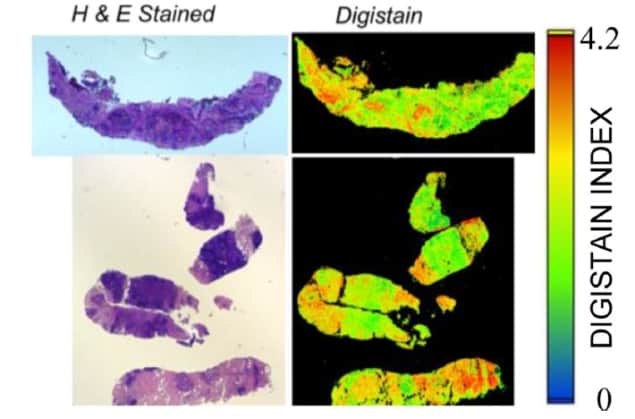
Researchers from Imperial College London have developed a new technology to grade tumour biopsies. The method, which uses mid-infrared imaging to map out chemical changes that signal the onset of cancer, could significantly reduce the subjectivity and variability in grading the severity of cancers (Converg. Sci. Phys. Oncol. 4 025001).
The majority of cancers are still diagnosed by doctors taking a biopsy of the tumour, then slicing it thinly and staining it with haematoxylin and eosin, vegetable dyes that have been used for over 100 years. They then examine this H+E stained sample under a microscope and judge the severity of the disease by eye alone.
Life-changing treatment decisions are based on this grading process, yet if the same biopsy is graded by different practitioners, they typically only agree about 70% of the time. This results in an overtreatment problem that constitutes a massive unmet need worldwide.
The team’s new “Digistain” technology addresses this problem by using mid-infrared imaging to map the nuclear-to-cytoplasmic ratio (NCR) – a recognized biological marker for a wide range of cancers – across an unstained biopsy section.
“Our machine gives a quantitative Digistain index (DI) score, corresponding to the NCR, and this study shows that it is an extremely reliable indicator of the degree of progression of the disease,” explained team leader Chris Phillips “Because it is based on a physical measurement, rather than a human judgement, it promises to remove the element of chance in cancer diagnosis.”
Phillips and colleagues performed a double-blind clinical pilot trial using two adjacent slices taken from 75 breast cancer biopsies. The first slice was graded by clinicians using the standard H+E protocol. It was also used to identify the region-of-interest (RoI) containing the tumour. The team then used Digistain to acquire a DI value averaged over the corresponding RoI on the other, unstained, slice and ran a statistical analysis on the results.
“Even with this modest number of samples, the correlation we saw between the DI score and the H+E grade would only happen by chance one time in 1400 trials,” said Phillips. “The strength of this correlation makes us extremely optimistic that Digistain will be able to eliminate subjectivity and variability in biopsy grading.”
The NCR factor that Digistain measures is common to a wide range of cancers. It is elevated by increased mitotic activity, because cells divide when they are younger and, on average, become smaller as the disease progresses. Also, extra DNA and RNA are generated as the nuclear transcription machinery goes awry. As such, it is likely that in the long run, Digistain will help diagnose a wide range of cancers.
The authors note that the Digistain imaging technology can easily and cheaply be incorporated into existing hospital labs.



